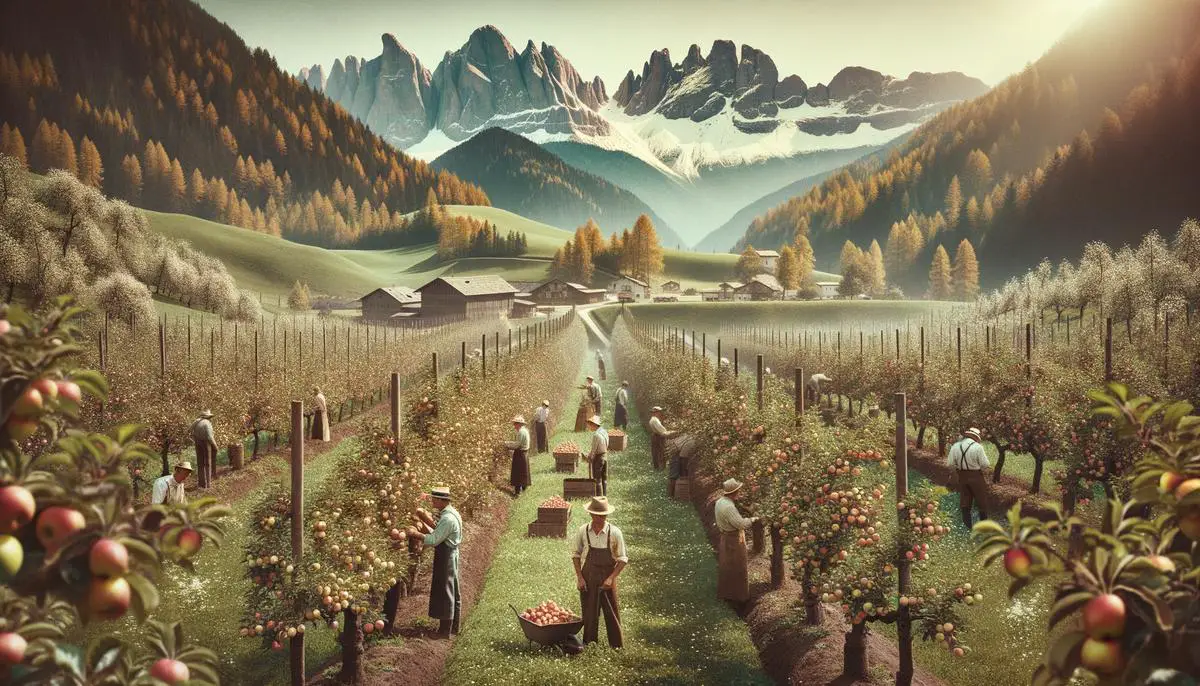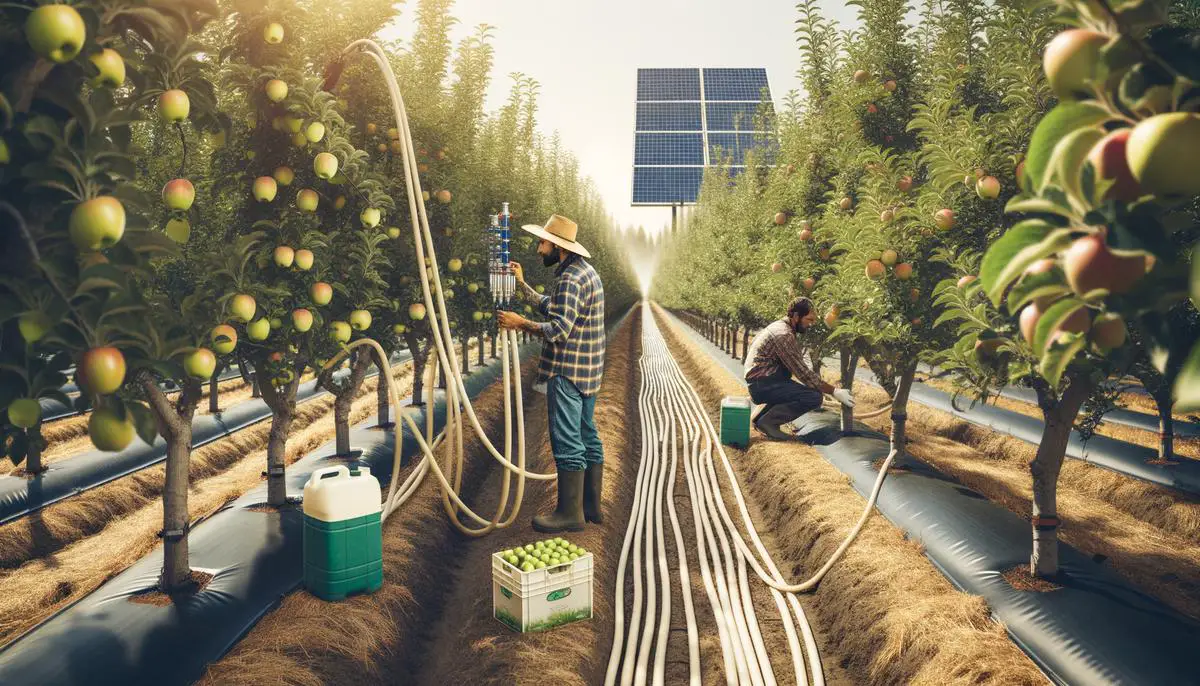South Tyrol's apple industry exemplifies the strength of cooperative frameworks. With thousands of growers collaborating, these cooperatives manage everything from storage to sales, creating an efficient system that sustains the region's apple production.
Role and Impact of Cooperatives
South Tyrol's apple industry thrives on its cooperative framework, resembling a well-oiled machine. Around 8,000 growers manage orchards averaging 2.3 hectares each, forming the foundation of this system. These growers own cooperatives that handle storage and packing, which, in turn, own two associations managing sales. At the top is the South Tyrolean Apple Consortium, responsible for branding and marketing. This structure sustains 95% of the region's apple production.
The origins date back to mid-1800s Austria, with Friedrich Wilhelm Raiffeisen pioneering the cooperative movement. His principles of mutual help and self-governance remain essential today. Later, Italy took control post-World War I, but South Tyrol retained substantial autonomy, focusing on agriculture.
In the U.S., cooperatives like Northwest Wholesale, Inc. in Washington play a crucial role in the tree fruit industry. This locally-owned cooperative manages both pre-harvest and post-harvest operations, helping maximize grower profits.
Financial Benefits of Cooperatives:
- Enhanced buying power
- Significant deals on supplies
- Savings returned to growers
- Money stays local, supporting the community
Challenges exist, of course. As new generations enter the farming sector, understanding and patience towards the cooperative model may decrease. In today's fast-paced society, waiting for year-end equity checks can seem less appealing than immediate discounts.
In China, the cooperative model brings environmental and economic advantages to apple production. Cooperatives reduced resource depletion and environmental impacts significantly while ensuring higher net profits compared to smallholders. They promote standardized farming inputs use, reducing transaction costs and increasing output quality, which is critical in meeting international market demands.
Locally, cooperatives provide continuous technical support through services like the Extension Service in South Tyrol, which offers independent information on plant protection products. This service, starting with 57 farmers in 1957, now includes around 6,000 members, demonstrating the strength of cooperative-backed support.
However, maintaining the delicate ecosystem of cooperatives requires understanding varied farmer needs. Differing motivations among poor and rich farmers necessitate a balanced approach in cooperative services to avoid skewed benefits.
While cooperatives significantly enhance production efficiency, challenges like land scarcity in South Tyrol and market monopolies in Europe push continuous adaptation. Despite these, the cooperative model remains a strong mechanism in sustaining and improving apple production worldwide.

Historical Context
The story of apple cooperatives traces back to the mid-1800s when the Austrian Empire controlled territories including modern-day South Tyrol. Friedrich Wilhelm Raiffeisen introduced principles of mutual help and self-governance that became the core of the cooperative movement.
After World War I, South Tyrol came under Italian control. By 1945, post-World War II, South Tyrol's apple industry was shaping its future with the creation of VOG, the region's first marketing association. This revival of agricultural collaboration birthed a structure that would eventually support around 8,000 growers, collectively nurturing Europe's largest contiguous apple area.
Concurrently, China's apple journey was preparing for its own transformations. From the late 1970s onward, China's agricultural system transitioned from communal farming to family-based management. This shift saw cooperatives emerge as leaders of this new model, combining traditional farming wisdom with innovative practices.
The 1980s and 1990s became the golden era of varietal diversification in South Tyrol. Growers, having succeeded with traditional apple varieties like Golden Delicious, explored newer options with Gala and Braeburn. It was like adding fresh hues to their palette, creating a vibrant canvas that extended far beyond the idyllic Adige Valley.
China's apple cooperatives streamlined eco-friendly methods and modernized agricultural practices. By leveraging collective wisdom and shared resources, these cooperatives managed to reduce environmental impacts and increase economic gains.
Throughout history, apple cooperatives have not only survived political and economic changes; they have thrived, adapted, and set benchmarks. Each farmer within these cooperatives plays a role akin to a note in a symphony—distinct yet harmonious, individual yet collective.

Case Studies: South Tyrol and China
South Tyrol's apple industry, known for its multi-layered cooperative framework, is a paragon of success in economizing efforts and optimizing results. The 8,000 growers, each tending to their orchards averaging 2.3 hectares, collectively form cooperatives that handle storage and packing. The South Tyrolean Apple Consortium sits atop this structure, crafting not just apples but a brand that resonates across Europe. This setup ensures that the apples don't just grow; they thrive, making up nearly 95% of the area's apple production.1
In the 1980s and '90s, South Tyrol's growers embraced new varieties like Gala and Braeburn. This diversification was a calculated move to capture broader markets and meet changing consumer tastes. Consequently, South Tyrol's apples aren't just any apples; they are the rockstars of the European market, boasting the titles of the continent's largest organic apple supplier and a significant exporter to Germany, Scandinavia, and Mediterranean countries.
The cooperative system also thrives on an intricate marketing and branding strategy orchestrated by the South Tyrolean Apple Consortium. By emphasizing stringent quality controls and a strong marketing campaign, they've carved a niche that goes beyond simply meeting demand—it anticipates and shapes it.
Turning to China, the story unfolds with equal measure of awe. China, the behemoth of apple production, introduced cooperatives as a pivot from their traditional farming methods to a modern, structured approach. Chinese cooperatives blend old wisdom with new technology, ensuring farmers don't just grow apples—they cultivate opportunities.
In Qingcheng County, Gansu Province, cooperatives have revolutionized apple farming. Unlike the fragmented efforts of individual smallholders, cooperatives have orchestrated a symphony of standardized practices. They introduce eco-friendly cultivation methods, mitigate resource depletion, and diminish environmental impacts. Imagine apples flourishing with fewer pesticides and fertilizers, yet yielding higher profits and better quality. That's hitting the agricultural jackpot!
Benefits of Chinese Apple Cooperatives:
- Eco-friendly cultivation methods
- Reduced resource depletion
- Diminished environmental impacts
- Higher profits
- Improved apple quality
Chinese cooperatives provide crucial technical support and training, equipping farmers with the latest advancements in agricultural practices. The result? A leap in production efficiency, soaring quality standards, and apples that can confidently waltz into international markets, meeting rigorous safety and quality benchmarks.2
South Tyrol and China's apple cooperatives prove that unity is not just strength; it's a strategy—a carefully crafted plan that encompasses efficient production, stringent quality control, and astute marketing. Their apples don't merely satisfy taste buds; they tell a story of resilience, collaboration, and relentless pursuit of excellence.

Economic and Environmental Impact
Apple cooperatives aren't just about growing tasty treats; they're reshaping economies and nurturing ecosystems. South Tyrol's orchards showcase this blend of agricultural prowess and sustainability. Cooperatives here have adopted efficient irrigation systems that conserve water while keeping apples thriving.
These cooperatives are financial wizards too. By pooling resources, they reduce costs through bulk purchases of fertilizers and pest control solutions. This collective bargaining power creates a virtuous cycle – savings on inputs get reinvested into sustainable practices, benefiting both wallets and the environment.
In Qingcheng County, China, cooperatives have become eco-friendly giants. They prioritize soil health, pushing for organic fertilizers and reduced chemical use. The results?
- Juicy, vibrant apples with a smaller environmental footprint
- Higher yields
- Enhanced quality
Cooperatives also open doors to international markets for small farmers. This exposure means better prices and improved livelihoods. They bring in mechanization too, boosting productivity while reducing labor hours.
South Tyrol's extension services, which started with just 57 members in 1957 and now boast 6,000 growers1, arm farmers with crucial plant protection information. This shared knowledge helps farmers avoid pitfalls and embrace innovations for better crops and profits.
It's a delicious synergy – cooperatives cultivate economic prosperity while sowing seeds of environmental stewardship.
So next time you bite into an apple, savor not just the taste, but the cascade of benefits rippling from field to market stall, rejuvenating both earth and farmer alike.

Challenges and Future Outlook
Apple cooperatives face a whirlwind of challenges in today's market. Globalization has turned the apple market into a shouting match, with South Tyrol's apples competing against fruits from New Zealand and Washington. The trick? Balancing time-honored traditions with rapid innovation to keep pace with global pressures.
Today's eco-conscious consumers want more than just an apple – they crave a story of sustainability and transparency. Cooperatives must pivot to meet these expectations, documenting their journey from orchard to basket.
The farming community itself is changing. Young, tech-savvy farmers are stepping in, their eyes gleaming at drones and digital monitoring systems. This generational shift brings both fresh energy and the need to harmonize with seasoned growers' wisdom.
To tackle these challenges, cooperatives are spinning intricate webs of strategy:
- Diversification: Exploring new, resilient apple varieties to charm consumers and buffer against monoculture risks.
- Tech embrace: Picture orchards with data-capturing drones, soil sensors, and automated irrigation. This isn't sci-fi; it's modern farming elevating efficiency and meeting international standards.
- Storytelling: Investing in marketing that narrates their journey, highlighting sustainability efforts and community impact.
- Continuous learning: Engaging younger farmers through workshops and leadership roles, creating a space where tradition meets innovation.
The path forward is one of dynamic adaptation. As cooperatives rise to these challenges, they're crafting a future where apples symbolize resilience, collective might, and harmonious evolution.
So, next time you crunch into an apple, remember – you're biting into a saga of history, struggle, and triumph. It's a celebration of cooperation and innovation, echoing from orchard to taste bud!

From South Tyrol's structured networks to China's eco-friendly practices, apple cooperatives prove that teamwork makes the dream work. As you munch your next apple, picture the intricate web of cooperation that brought this crunchy delight to your hand. It's not just fruit – it's a bite-sized revolution!